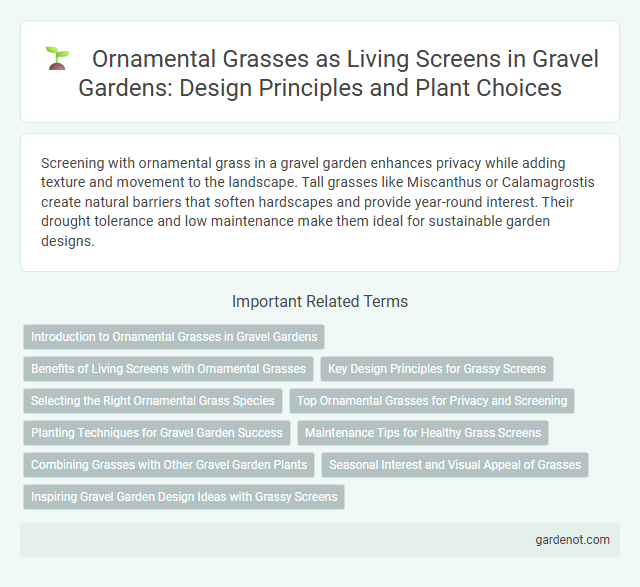Screening with ornamental grass in a gravel garden enhances privacy while adding texture and movement to the landscape. Tall grasses like Miscanthus or Calamagrostis create natural barriers that soften hardscapes and provide year-round interest. Their drought tolerance and low maintenance make them ideal for sustainable garden designs.
Introduction to Ornamental Grasses in Gravel Gardens
Ornamental grasses provide an effective natural screen in gravel gardens, combining aesthetic appeal with functional privacy. Species such as Miscanthus sinensis and Pennisetum alopecuroides thrive in well-drained, gravelly soil and require minimal maintenance. Their tall, flowing textures create a dynamic, year-round visual barrier while enhancing biodiversity and soil stability.
Benefits of Living Screens with Ornamental Grasses
Living screens with ornamental grasses in gravel gardens provide year-round privacy by creating dense, tall barriers that filter noise and block unsightly views. These grasses enhance biodiversity by supporting pollinators and small wildlife, while their deep root systems improve soil structure and prevent erosion. Low maintenance and drought-tolerant, ornamental grasses conserve water and thrive in gravel garden conditions, making them sustainable privacy solutions.
Key Design Principles for Grassy Screens
Ornamental grasses create effective gravel garden screens by combining height, density, and texture to establish natural boundaries and privacy. Selecting species with varying growth habits and seasonal interest enhances visual appeal while maintaining airflow and light penetration. Strategic spacing and layering of grasses ensure a dynamic, low-maintenance barrier that complements the minimalist aesthetic of gravel gardening.
Selecting the Right Ornamental Grass Species
Choosing the right ornamental grass species for screening in a gravel garden depends on factors such as height, growth habit, and environmental tolerance. Popular species like Miscanthus sinensis offer tall, dense foliage ideal for privacy, while Festuca glauca thrives in well-drained gravel soils with low water needs. Integrating native grasses like Calamagrostis acutiflora enhances sustainability and supports local biodiversity in the garden.
Top Ornamental Grasses for Privacy and Screening
Tall varieties like Miscanthus sinensis and Pennisetum alopecuroides create dense, elegant screens perfect for gravel garden privacy. Festuca glauca and Calamagrostis acutiflora offer fine texture and year-round interest with their graceful movement and color variation. These ornamental grasses thrive in well-drained gravel soil, providing natural sound barriers and wind protection while enhancing landscape aesthetics.
Planting Techniques for Gravel Garden Success
Screening with ornamental grass in gravel gardens requires selecting species with dense foliage and upright growth, such as Miscanthus sinensis or Pennisetum alopecuroides, to create effective visual barriers. Planting in groups with staggered spacing enhances coverage while ensuring air circulation, reducing the risk of fungal diseases. Using well-draining soil amendments and applying mulch helps maintain moisture levels and supports root health in the challenging gravel garden environment.
Maintenance Tips for Healthy Grass Screens
Ornamental grasses in gravel gardens require regular watering during dry spells to maintain vibrant foliage and prevent drought stress. Trimming dead or damaged leaves in early spring encourages fresh growth and enhances the screen's density. Applying a balanced slow-release fertilizer in spring supports root development and ensures year-round lushness.
Combining Grasses with Other Gravel Garden Plants
Ornamental grasses create dynamic texture and movement when combined with drought-tolerant gravel garden plants such as lavender, sedum, and echinacea. Their slender, arching foliage contrasts beautifully with the rosette forms of succulents and the structured shapes of yucca or agave. Integrating grasses like Festuca glauca or Pennisetum alopecuroides enhances biodiversity and provides seasonal interest with minimal maintenance in gravel garden landscapes.
Seasonal Interest and Visual Appeal of Grasses
Ornamental grasses in a gravel garden provide dynamic seasonal interest through their changing textures and colors, ranging from vibrant green blades in spring to warm golden hues in autumn. Their tall, feathery plumes add visual appeal and soften hard surfaces, creating movement and contrast against the gravel's rigid structure. Selecting varieties like Miscanthus or Pennisetum enhances year-round screening, combining privacy with an attractive, natural aesthetic.
Inspiring Gravel Garden Design Ideas with Grassy Screens
Inspiring gravel garden design ideas often incorporate ornamental grasses as natural screens, enhancing privacy while adding texture and movement. Varieties like Miscanthus sinensis and Pennisetum alopecuroides thrive in gravelly soils, creating elegant, wind-swaying barriers that complement minimalist landscapes. These grassy screens not only define spaces but also attract pollinators, enriching the garden's ecological value.
Screening with ornamental grass Infographic

 gardenot.com
gardenot.com